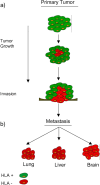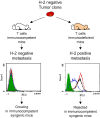The selection of tumor variants with altered expression of classical and nonclassical MHC class I molecules: implications for tumor immune escape
- PMID: 15069585
- PMCID: PMC11032983
- DOI: 10.1007/s00262-004-0517-9
The selection of tumor variants with altered expression of classical and nonclassical MHC class I molecules: implications for tumor immune escape
Abstract
Tumor immune escape variants can be identified in human and experimental tumors. A variety of different strategies are used by tumor cells to avoid recognition by different immune effector mechanisms. Among these escape routes, alteration of MHC class I cell surface expression is one of the mechanisms most widely used by tumor cells. In this review we focus our attention on the T-cell immune selection of MHC class I-deficient tumor variants. Different altered MHC class I phenotypes that originate from multiple molecular mechanisms can be identified in human tumors. MHC-deficient tumor clones can escape T-cell immune responses, but are in theory more susceptible to NK-cell-mediated lysis. In this context, we also review the controversial issue of the aberrant expression of nonclassical HLA class I molecules, particularly HLA-G, in tumors. This expression may be relevant in tumor cells that have lost the capacity to interact with NK inhibitory receptors-namely, those tumor cells with no HLA-B or HLA-C expression. Most published studies have not analyzed these possibilities and do not provide information about the complete HLA-A, HLA-B, or HLA-C molecule profiles of the tumors studied. In contrast, HLA-E has been reported to be expressed in some tumor cell lines with very low HLA-A, HLA-B, and HLA-C expression, suggesting that HLA-E may indeed, in some cases, play a role by inhibiting NK lysis of cells that otherwise would be destroyed by NK cells. Finally, we provide evidence that the status of the immune system in the tumor-bearing animal is capable of defining the MHC profile of the tumor cells. In other words, MHC class I-negative metastatic colonies are produced in immunocompetent animals, and MHC class I-positive colonies in T-cell immunodeficient individuals.
Figures


References
-
- Algarra Int J Cancer. 1991;6:73.
-
- Boon Annu Rev Immunol. 1994;12:337. - PubMed
Publication types
MeSH terms
Substances
LinkOut - more resources
Full Text Sources
Other Literature Sources
Research Materials

